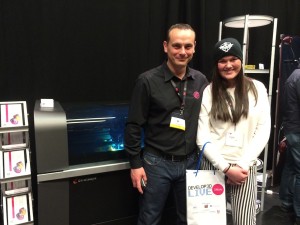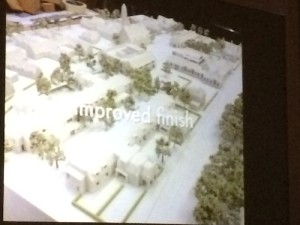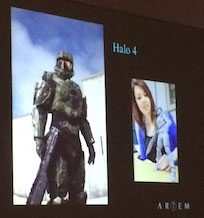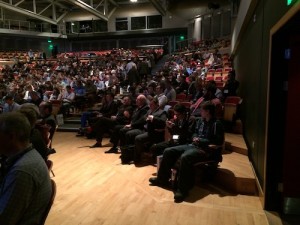I’m not sure I know of anyone that looks forward to their alarm going off at 5 am, least of all my 16 year old daughter. Yesterday, however, she rose at precisely that time, without complaint I might add, to accompany me to the third edition of Develop3D Live, being held once again at the Warwick Arts Centre on the Warwick University campus.
I had presented her with the opportunity to come a few weeks back when it first occurred to me that the event was taking place during the Easter holidays. She is preparing to take her GCSE examinations in May, one of which is Product Design. Over the last two years of her studies, it has emerged as a highlight on her timetable. She says this is due, in part, to an inspiring teacher and in part to me “going on about it!” Overlooking the teenage attitude, I take this as a compliment.
It was a fast and easy journey down to Coventry, not least because I had company in the car. Coffee for me, Red Bull for her and we were set for the day. At registration we were greeted by a bleary eyed but very cheery Stephen Holmes, who had indulged at the networking evening the night before. Stephen is part of the fabulous D3D team organizing and hosting the annual live event, along with Al Dean, Martyn Day and Tanya Weaver who were all on top form during the day, despite the evening time indulgences. Martyn opened the conference and one of his main points was crediting the tight team that he is a part of. Despite working disparately they are tight-knit and very productive, something I can identify closely with. The high level of respect they command across the industry with the D3D portfolio is well deserved.


It was also lovely to see the guys from Blueprinter at the show. After catching up, and hearing that things are going well, I did give Peter Hansford a bit of a ticking off, telling him we need more user stories. He’s promised there will be some coming soon.
At which point, the conference was due to get underway, so we headed over to the already populated Butterworth hall for the first two headline keynote presentations. These were standouts on the programme and the organizers knew it and had nothing running concurrently with them.
Daniel Simon had everyone’s attention from the get go. With a title of “Dream Machines for Film and Life: Tron, Oblivion and the Timeless Racer” in a male dominated industry, there were always going to be drooling delegates.
It’s not just dream machines though, as a concept designer in Hollywood and an ‘automotive futurist’ he has, I would say, the dream job according to 99% of the population of that room. This was backed up by the seemingly endless queues for the book signing session Daniel agreed to. D3D had brought in every last one of Daniel’s books available in the UK — they went in under an hour!

Spot on!
The second of the headline presentations did not lose the audience’s attention. If you’re going to follow automotive fantasy with reality, the only way to go is Formula 1. Champions at that. Al Peasland is Head of Technical Partnerships at Red Bull Racing, and despite working in marketing (gets him to more races, apparently) he is qualified engineer. This was clever scheduling and it worked well as Al described one of the fastest and most successful ascensions to success in F1 history. And this all comes down to precision concept design to final manufacture — and everything inbetween — using the right 3D tools and forging the right partnerships. Al’s presentation was peppered with video clips that got oohs and aahs, not least the 1.9 second clip showing the fastest ever pit stop! Blink and you missed it — but it made a salient point, the Red Bull team strive for performance perfection at every single level.
And they love it. Which is probably why they can boast 169 races, 57 pole positions, 47 race wins, 105 podiums and 24995 points after starting at the back of the grid 6 years ago.
Talking team and technology this presentation blended the inspirational, the aspirational and the reality of producing increasingly sophisticated, high performance cars. The range of software was covered from earliest design to FEA and CFD simulations, not to mention the vast amounts of data the team is dealing with on a daily basis. The thing has to be perfect ahead of the £100k FIA compliant crash test — that was an eye opener — all against the tightest deadlines and complicated logistics.
Basically it is as fun and as glamourous as it looks, but it is also DANGEROUS. Al showed a clip of Mark Webber’s 2010 crash, one that 10 years ago he would have been lucky to be alive after, let alone walk away unscathed. The point being, the fact that he is seen showing his anger from the cockpit (chucking his wheel out) demonstrates the team’s pathological attention to detail — at every level.
Oh, and there are a fair few 3D printed parts on the car, and 3D printing is used heavily during development for prototyping, but to be honest, in this presentation, that was by the by!
And that was actually a theme I picked up on through the day. Having appraised the programme before hand, with four presentation streams available at any one time, Laura and I had agreed to split up after the first keynote session — me to 3D Printing, she to Product Design and Engineering. Other choices included a continuation of keynote sessions (does anyone else remember a time when there was one keynote kicking off a conference. Full stop!?) and Design Visualisation and Rendering. I think she was a little uncertain about heading off into the unknown alone, but my daughter doesn’t tend to let things like uncertainty hold her back. Fortuitously, however, she didn’t have to as we met up with the lovely Russell Beard who runs his own product design consultancy — Square Banana — in Cheltenham (and writes a wicked blog) who was heading into the same session, he gallantly accompanied her.
And thus I headed the other way. Unfortunately, a few presentations on the published 3D printing programme were changed at short notice due to unforeseen circumstances, so I didn’t get to see/hear/meet some of the people I had on my planner. Michelle Greef, a director of 3D Hobs Studio had stepped in over the weekend to fill in the first slot on the programme and she was talking Man vs Machine; essentially illustrating the trade-off between traditional model making skills and 3D printing, with an AEC industry focus. Her main take away being that it is when they are combined that the truly great models are produced. 3D printing is a valuable tool — in terms of time and money, but it can never take away the need for skilled models.
Michelle’s presentation highlighted some fantastic models, not least a 2m x 2m model produced in four days, and skillfully finished thereafter. Or one of the amazing cross section models that 3D printing is so good at. Another was an interactive model, with removable parts that can be redesigned and added quickly and easily, as seen here.

But like with the F1 presentation, it’s kind of by the by, it’s just a part of a much greater process. A process that involves 3D scanning, digital design, freeform design, 3D robots, CNC machines and, yes, 3D printers. It’s the end result that matters and the overall process that gets them there, usually against the clock — the tools are just tools. Yes they make the job easier in many ways, and the results are incredibly superior to 10 years ago, but I think you probably get the gist.

Only people — with a combination of skills and an understanding of a broad range of technologies — fulfill the deadlines.
Then I had a lunch date with my daughter. And I got to introduce her to more lovely people. Tracy and Ross Nicholls from MNL, Steve Willmott from Ogle Models + Prototypes, Kevin Quigley of Quigley Design and Kerry Hogarth were just some of the people she was happily chatting with and recalled later. Dave and Mark from Laser Lines left a lasting impression too :-/
I was also able to show her first hand the parts from different 3D printing processes, courtesy of the range of companies there. She’d seen the Envisiontec and Connex stuff earlier in the day, but I also got to show her entry level FDM parts next to Dimension and Fortus parts, as well as parts off a voxeljet machine, Concept Laser parts, ProJet parts and so on. It certainly opened her eyes way further than “have you seen this,” and pointing to a computer image, which is what happens at home. You can never EVER beat, seeing and touching 3D printed parts at first hand to understand it better.
We caught a few more of the Keynote presentations after lunch. I was looking forward to Hardi Meybaum’s talk. Hardi is the CEO of 3D content community GrabCAD, which he founded in 2010, it has grown phenomenally in the last four years with almost 1.2 million users and 20 million downloads. Hardi highlighted some of the GrabCAD success stories, putting the success down to the ethos of the WorkBench environment that allows disparate teams to work together in real time, with minimal training regardless of the 3D environment they are used to.
And then the 5am start caught up with us. We toyed with staying for the prize draws, but we unanimously voted to get a jump on the M6!
My only complaint about D3D remains — it’s too much information in a single day. The four streams of quality presentations could easily fill two days, and still have the same complaint levelled at them! Although, as Al said, his liver might not survive the extra day! Therefore, I look forward to the videos of the presentations being loaded to the D3D Live website in the coming weeks.
My main take away of the day? To try and avoid being so consumed by 3D printing and to take a step back more often to look at the much bigger, very exciting picture.
Talking to Laura on the way home, her highlights were the presentations of Jon Riley and Mark Shaylor. The second in particular seems to have hit home and she told me that if she does design ‘things’ for a living in the future, she would want to approach it like him in way that “makes things better — literally and figuratively —and in a way that is friendly to the environment. That’s always a bonus.” Oh, and she also told me that it’s nice that my life is not as boring as she thought it was and that I know some great people!




